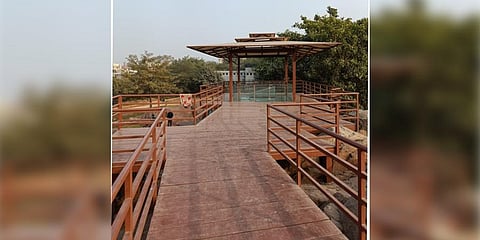

NEW DELHI: Ashok Rock Edict site, located near Kailash Hills in south Delhi, is set to get a new lease of life with the Archaeological Survey of India (ASI) undertaking a major exercise to spruce up the place and conserve the inscription. According to the survey, the stone edict dates back to 273-236 BC which was discovered in 1966.
The site attracts tourists, including Buddhist monks, from neighbouring countries. It is among three inscriptions, which include the teachings of Lord Buddha, built by Mauryan emperor Ashoka. The other two are — the Delhi Topra pillar installed in Feroz Shah Kotla, and the Ashoka Pillar in Kamla Nehru Ridge near Hindu Rao Hospital.
Until recently, the edict would rest under an untidy concrete structure protected by iron gate and fencing. The visitors had to walk on an elevated pathway made of stone. The cement-mortar structure and iron fencing have been replaced with neat glass and steel enclosure. The inscription is also encased in protective glass cover.
The pathway to the rock has also been re-laid; uneven stones have been replaced by wood planks. To preserve the ancient edict, the rocks surrounding the edict aren’t removed, which marks the park as a unique one. The survey has also started enhanced landscaping at the site. A network of pipelines is being laid around the edict to install sprinklers for irrigating the grass and plants.
“We are planning to lay a Japanese grass bed and for that, we have already laid a layer of soil that will support the grass. Earlier, the land around the rocks, where an edict is placed, was a barren and dusty patch. To enclose the park, we will convert the iron fencing to concrete ones so that it stays safe. We are planning to make arrangements for benches, dustbins, washrooms, drinking water facility and lights too. If things go as per plan, we will complete this project by February,” said an ASI official.
The rock has manuscripts engraved on it by the great Mauryan emperor Ashoka in the Prakrit language in Brahmi script. This is one of the minor rock edicts that speaks of his exertion in the cause of Dhamma. As mentioned in the plaque at the entrance of the park, Ashoka was trying to bring his countrymen closer to God with this edict. It says that he made all his efforts to convince them irrespective of their social status, to exert so that they can pursue heaven.